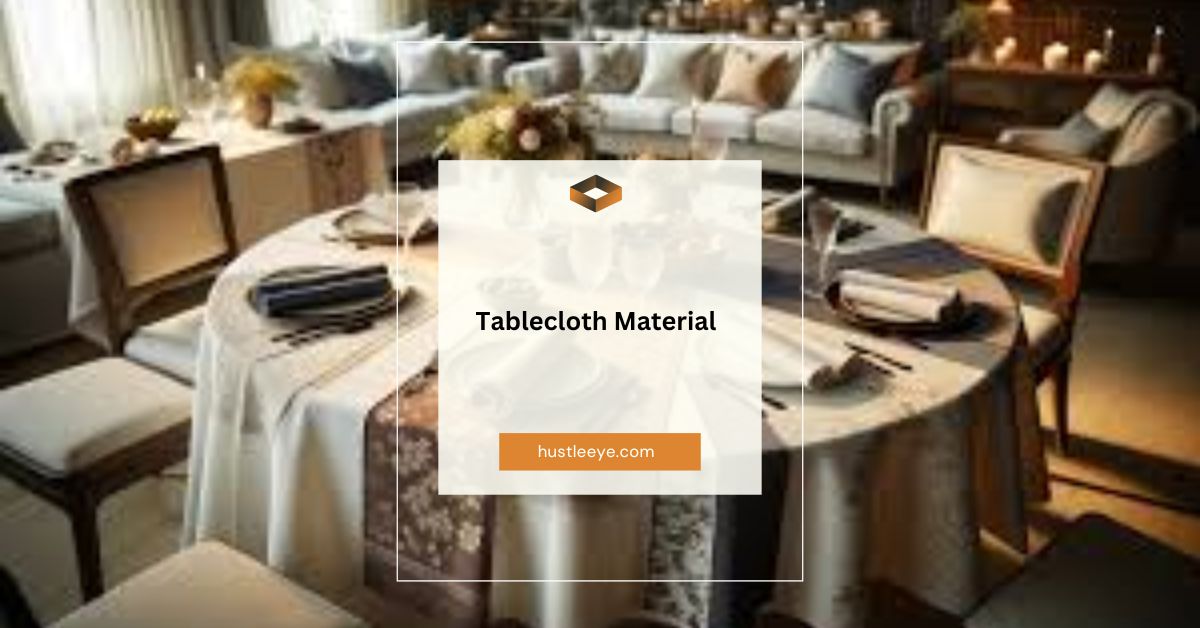When you think of setting the perfect table, the material of your tablecloth plays a huge role in the overall aesthetic and functionality. Whether you’re hosting a formal dinner, a casual brunch, or an outdoor picnic, the right tablecloth material can elevate the ambiance and set the mood for the occasion. Tablecloth materials come in a variety of fabrics, each with its own set of advantages, durability, and care requirements.
In this comprehensive guide, we’ll explore the different types of tablecloth materials and their uses, including a detailed look at “tablecloth material nyt” and its relation to the popular New York Times crossword puzzle. Additionally, we’ll provide FAQs and practical tips for choosing the perfect material for your tablecloths.
Table of Contents
Understanding Tablecloth Materials: Overview
Tablecloths are more than just a protective layer for your table; they are an essential element in decorating your dining area and setting the right tone for your event. The material you choose affects not only the visual appeal but also the durability and practicality of the tablecloth. There are many factors to consider, including the material’s ability to withstand spills, its texture, ease of care, and whether it complements your table’s style.
Tablecloth Material NYT Crossword Clue:
If you’re a crossword enthusiast, you might recognize the term “tablecloth material nyt” as it relates to crossword puzzles. On April 25, 2024, the New York Times Mini Puzzle featured a clue for “Tablecloth material,” and the answer was “LINEN.” This fabric is a popular choice for tablecloths, known for its luxurious feel and durability.
Linen has been a go-to material for centuries, symbolizing elegance and sophistication. In the context of the crossword puzzle, it’s a succinct answer that fits perfectly within the grid, but in real life, linen offers far more than just puzzle-solving satisfaction. We’ll explore linen in greater detail later in the article, along with other materials commonly used for tablecloths.
Read More: rTasks Login: A Comprehensive Guide for Easy and Efficient Task Management
Types of Tablecloth Materials:
When selecting a tablecloth, it’s essential to choose a material that fits the occasion and serves the practical needs of your space. Let’s explore the most common tablecloth materials:
1. Linen:
Linen is a top choice for formal events and upscale dining experiences. It’s made from the fibers of the flax plant and is known for its softness, breathability, and natural sheen. Linen tablecloths drape beautifully over tables, adding an air of sophistication.
- Advantages: Luxurious appearance, durable, and breathable.
- Disadvantages: Requires ironing, can be expensive, and stains are harder to remove.
2. Cotton:
Cotton tablecloths are popular for casual dining and everyday use. They are soft, absorbent, and come in a wide variety of colors and patterns. Cotton is also relatively affordable and easy to care for.
- Advantages: Affordable, easy to clean, and comfortable.
- Disadvantages: Prone to staining and wrinkling.
3. Polyester:
Polyester tablecloths are prized for their durability and resistance to stains and wrinkles. They are often used in restaurants and for events where practicality and longevity are key.
- Advantages: Low maintenance, stain-resistant, and budget-friendly.
- Disadvantages: May feel less luxurious compared to natural fibers.
4. Vinyl:
Vinyl tablecloths are ideal for outdoor use, as they are water-resistant and easy to wipe clean. They are perfect for picnics, barbecues, and children’s parties.
- Advantages: Waterproof, easy to clean, and affordable.
- Disadvantages: Can appear less formal, not as durable in the long term.
5. Satin and Silk:
Satin and silk tablecloths are synonymous with luxury and elegance. They are often used for special occasions such as weddings, anniversaries, and other formal events.
- Advantages: Exquisite appearance, soft texture.
- Disadvantages: Expensive, delicate, and requires careful maintenance.
6. Lace:
Lace tablecloths are decorative and often used as overlays on top of another fabric. They add a touch of vintage charm and are typically reserved for formal settings.
- Advantages: Elegant and decorative.
- Disadvantages: Delicate and not practical for everyday use.
7. Flannel-backed:
Flannel-backed tablecloths provide a bit of cushioning and are typically used for outdoor events or casual indoor dining. The flannel backing helps protect the table from scratches and spills.
- Advantages: Soft backing provides protection, easy to clean.
- Disadvantages: Can look less formal.
Read More: Exploring https://freeworlder.org/: A Pathway to Positive Change
Best Tablecloth Material for Different Occasions:
Choosing the right tablecloth material depends on the type of event you’re hosting. Here’s a quick guide:
- Formal Events: Linen, satin, silk, lace.
- Casual Gatherings: Cotton, polyester.
- Outdoor Events: Vinyl, flannel-backed.
- Special Occasions (e.g., weddings): Silk, satin, lace.
Durability and Care Guide for Each Material:
Understanding how to care for your tablecloth material can significantly extend its lifespan. Here’s how to maintain some of the most popular materials:
- Linen: Hand wash or use a gentle machine cycle. Always iron while damp for a smooth finish.
- Cotton: Machine washable but may need ironing to remove wrinkles.
- Polyester: Easy to care for; machine wash and typically wrinkle-free.
- Vinyl: Simply wipe clean with a damp cloth.
- Satin and Silk: Dry clean only to maintain their delicate texture.
- Lace: Hand wash with care to prevent tearing.
Read More: LookWhatMomFound: A Complete Guide to a Unique Parenting Blog
Eco-friendly and Sustainable Tablecloth Materials:
As environmental awareness grows, many people are opting for sustainable tablecloth materials. Linen, for instance, is a natural fiber that is biodegradable. Recycled cotton and organic fabrics are also becoming popular choices for those looking to reduce their environmental impact.
Other eco-friendly materials include bamboo and hemp, which are both renewable resources and offer durability and style
Trends in Tablecloth Designs and Materials in 2024:
In 2024, the trend in tablecloths is leaning towards minimalism and eco-consciousness. Neutral tones, sustainable fabrics, and textured materials like raw linen are in vogue. Additionally, many designers are experimenting with digital prints and patterns that add a contemporary edge to traditional tablecloth designs.
Read More: LookWhatMomFound.com: A Comprehensive Guide for Families and Parents
How to Choose the Right Tablecloth Size:
Choosing the right tablecloth size is crucial to achieving the desired look for your table setting. The general rule is to allow for an overhang of at least 6 to 12 inches on each side. For formal events, a longer drop of up to 18 inches is preferred.
To calculate the correct tablecloth size:
- Measure the width and length of your table.
- Add twice the desired overhang to both measurements.
Read More: Exploring Neuronpostshop.com: Revolutionizing Tech News with AI, Automation, and Innovation
Frequently Asked Questions (FAQs)
1. What is the best material for everyday use?
Cotton and polyester are the best materials for everyday use because they are easy to clean and maintain, offering both comfort and durability.
2. How do I remove stains from linen tablecloths?
Stains on linen should be treated as soon as possible. Use a gentle stain remover and wash in lukewarm water. Avoid harsh chemicals that may damage the fabric.
3. Are polyester tablecloths durable?
Yes, polyester tablecloths are very durable. They resist stains and wrinkles, making them ideal for events where spills are likely.
4. Can tablecloths be eco-friendly?
Yes, tablecloths made from organic cotton, linen, bamboo, or hemp are eco-friendly choices. These materials are renewable and biodegradable.
Conclusion:
Choosing the right tablecloth material is a balance between aesthetics, functionality, and ease of care. Whether you’re selecting linen for a formal dinner, vinyl for an outdoor barbecue, or cotton for daily meals, the material you choose will impact the dining experience. Consider factors like durability, stain resistance, and the occasion when picking your tablecloth material.
For those who came across the “tablecloth material nyt” crossword puzzle clue, the answer is “linen,” a fabric that symbolizes elegance and has stood the test of time in both practical and decorative use. When selecting a tablecloth for your next event, consider the insights and tips provided in this guide to make the best choice for your needs.


